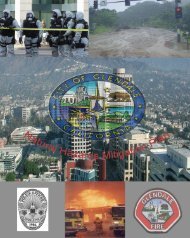Sayre Report - Hazard Mitigation Web Portal - State of California
Sayre Report - Hazard Mitigation Web Portal - State of California
Sayre Report - Hazard Mitigation Web Portal - State of California
Create successful ePaper yourself
Turn your PDF publications into a flip-book with our unique Google optimized e-Paper software.
• Potential effects to water quality downstream <strong>of</strong> the burned area due to<br />
an increase in water turbidity. Increase turbidity downstream is<br />
expected as a result <strong>of</strong> increase sediment and debris coming from the<br />
burn area.<br />
• Potential impacts to water quality from burned anthropogenic (manmade)<br />
sources.<br />
B. Conditions <strong>of</strong> Values at Risk<br />
Areas with the high soil burn severity produce the greatest changes. High soil<br />
burn areas exhibit hydrophobicity, a condition <strong>of</strong> water repellency created by<br />
heat <strong>of</strong> the fire which volatizes the organic matter. High soil burn areas also<br />
have little organic material left, or display white ash. Areas with moderate soil<br />
burn severity produce less change, with more organic material present. Areas<br />
with low soil burn severity produce very little change and unburned areas<br />
produce no change. In light <strong>of</strong> the defining conditions above, most <strong>of</strong> the<br />
observed burn areas in the <strong>Sayre</strong> fire are moderate to low burns.<br />
Because the precipitation is not absorbed as it usually is, and instead is<br />
immediately mobilized, the effects from burned areas are probably the most<br />
severe during the first significant storm event, which is also dependent on the<br />
amount <strong>of</strong> precipitation. Consequently, years with expected higher rainfall<br />
should expect compounded effects from the fire regarding erosion, turbidity,<br />
and debris flows.<br />
Excluded from the general term <strong>of</strong> moderate burn above is the Oakridge<br />
Mobile Home Park (Oakridge) which is located at the base <strong>of</strong> the foothills in<br />
Sylmar. Approximately 480 mobile homes burned to the ground. Much <strong>of</strong> the<br />
remains <strong>of</strong> most <strong>of</strong> the mobile homes were the metal frames that were not<br />
consumed in the combustion. However, it is assumed that because the<br />
structures were lost, are on a slope, and that burned anthropogenic materials<br />
remain, the potential for these materials to be mobilized is increased during a<br />
rain event. If that is the case, there is potential for impact to waters <strong>of</strong> the<br />
state or U.S. if the drainage from the materials at Oakridge is not diverted,<br />
contained, or sent to a water treatment facility.<br />
On Thursday, December 11, 2008, I and another member <strong>of</strong> the <strong>Sayre</strong> Fire<br />
team made a return inspection to Olive View Hospital (Hospital) because <strong>of</strong><br />
concerns <strong>of</strong> purported possible hazardous materials exposed onsite. We met<br />
a Compliance Officer at the Hospital who indicated that a “county hazmat<br />
team” had previously visited the site with instructions regarding specific<br />
burned areas. With that in mind, we toured the area with the hospital facility<br />
planner staff. Some areas were fenced <strong>of</strong>f and being cleaned up with<br />
attendant personnel. No outstanding hazardous materials seemed to be<br />
exposed during our inspection.

















